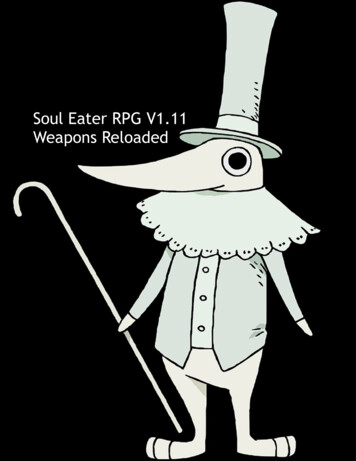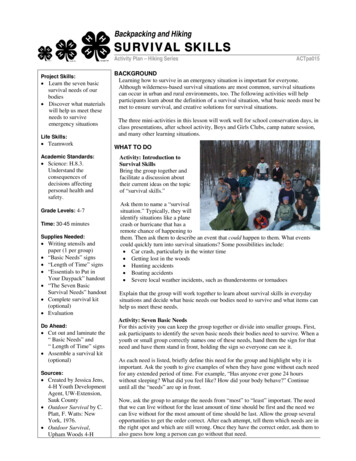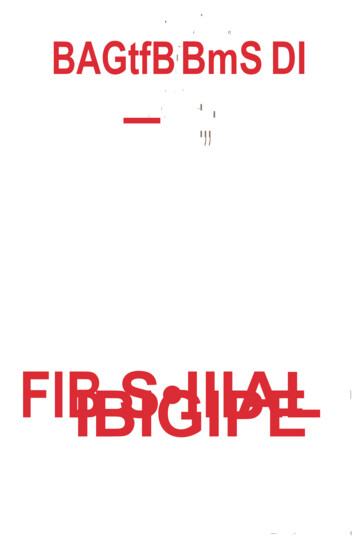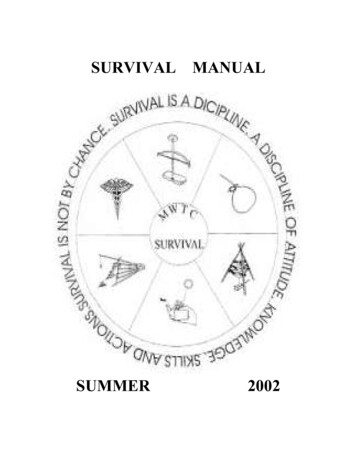
Transcription
Throwing StickVariations of the throwing stick or rabbit stick can be found in many cultures all over theworld, also known as a throwing club, throwing wood, baton, kylie, or the well knownreturning and non-returning boomerangs of the Australian aborigine’s. Used for huntingsmall mammals and birds, typically made from medium or hardwood, 12 to 24 inches inlength with one end either weighted by a thicker heavier section or a curve. This extraweight or curve imparts momentum to the stick when thrown, increasing flight stability. Idon’t fully understand the physics and subtleties of the various different designs, butthere seems to be four basic styles: club, equal single bend (a stretched ‘V’ shape, lessthan 45 degrees), unequal single bend (a stretched ‘L’ shape) and double bend (a stretched‘Z’ shape), examples are shown in figure 9.1.1. From reading around and searching theweb, you don’t normally see a straight, constant diameter throwing stick, the exception tothis is when metal, typically lead is used weight one end. Throwing sticks having a bendare normally thinned downed flat i.e. a bi-convex or thin oval, improving theiraerodynamic profile, reducing weight, therefore, allowing them to travel greaterdistances. This profile is optimised for the returning boomerang, forming an aerofoilprofile i.e. a flat bottom and a curved top, allowing the boomerang to generate lift. Acommon characteristic of these throwing sticks is that their edges are thinned down to apoint, concentrating the kinetic energy on impact. Club type throwing sticks have a solidbulge, protuberance e.g. circular or oval, at one end and tend to be shorter than curvedthrowing sticks. Again the club end may be pointed to concentrating the kinetic energy onimpact e.g. pointed, forked, tear drop or conical.
Figure 9.1.1 : Throwing Sticks
Throwing sticks with a bend are thrown using an overhand, sideways throwing action,imparting a spinning motion on the stick. This sideways spinning flight path increases theprobability of making contact with the target. Some quotes on using throwing sticks:“No deviation normal throwing sidearm motion, distal wing curved inward, projectilelow to the ground was indicated. The throwing arm moved with a broad sweep using thewhole arm but with some degree of wrist snap at the end of the action” Koerper,Pinkstopn and Wilken“First, align the target by extending the non-throwing arm in line with the mid to lowersection of the target. Slowly and repeatedly raise the throwing arm up and back until thethrowing stick crosses the back at about a 45-degree angle or is in line with the nonthrowing hip. Bring the throwing arm forward until it is just slightly above and parallelto the non-throwing arm. This will be the throwing stick's release point.” The Web“The throwing wood is a crooked piece of wood, which is able to fly with or withouthaving a grip. Generally it is thrown and then rotates in the air, but occasionally it alsocan be used as a club. Unlike the throwing club, the throwing wood does not concentrateon the effect of hitting. Only the variant which returns to the thrower is called aboomerang.” Lenoch“Such a basic club can be thrown either overhand (when, for instance, you're trying tohit the side of a tree) or sidearm (when you're in an open area, where brush won'tinterfere with the stick's flight). In using the first method, point your left foot at the target(if you're a right-hander southpaws can simply reverse these directions). Then, holdingthe smaller end of the stick loosely in your right hand, bring the weapon back over yourshoulder and hurl it, with good end-over-end spin, straight at the mark. At the moment ofrelease, your shoulders should face the target squarely. The sidearm throw is similar tothe motion used in stroking a tennis ball with the racket. Point the left toe at the target,bring the stick to a cocked position at your side, and throw it, squaring your shouldersand snapping the club as if you were cracking a whip to give it spin.” BrownClub type throwing sticks can be thrown using a more targeted throwing action. Again,thrown using an overhand throwing motion, however, this time no sideways spin is usedi.e. the club is thrown straight, heavy end first, this end making contact with the target.The handle increasing leverage and speed allowing the club to be thrown further andfaster. Some books suggest that a twisting flick should be added just before release i.e.rotating the club inline with the directions of travel, improving its stability in flight.
Figure 9.1.2 : Equal single bend throwing sticksFigure 9.1.2.1 : Club throwing sticks
Figure 9.1.2.2 : Double bend throwing sticksFigure 9.1.2.3 : Long single bend throwing sticks
Figure 9.1.2.4 : Weighted throwing sticksTo make a throwing stick that contains a bend the simplest solution is find a piece ofwood with a suitable natural bend, although this is sometimes easier said than done.However, as this type of throwing stick is normally thinned down to a flat profile, anyunwanted bends or bumps can be minimised or removed completely with a bit ofjudicious trimming. When a suitable piece of wood cannot be found the wood can beformed into a curve by heating and bending. One technique I’ve read about is to heatgreen wood over hot coals to make it pliable, then placed it between two rocks, placing aheavy pressure rock on top to form the bend. Alternatively the wood could be steamed tomake it more flexible, removed from the rocks when cooled.The equal length single bend throwing stick shown in figure 9.1.2 is made from Beech,cut down and shaped using an axe to give a more aerodynamic profile. The club throwingstick shown in figure 9.1.2.1 is made from an evergreen shrub, not sure what species, amedium hardwood. Using a saw, stop cuts are made around the head, an axe is then usedto form the handle (the stop cuts preventing the splits progressing to far). The doublebend throwing stick shown in figure 9.1.2.2 is made from Ash, simply cut down andshaped using an axe. Ideally the top and bottom bends need to be a little longer and moreangled, but this was the best of the wood available. The long single bend throwing stickshown in figure 9.1.2.3 is made from Birch. The bend is naturally formed, again shapedto improve its aerodynamic profile. Comparing these throwing sticks with sometraditional non-returning Australian aboriginal boomerangs from the central desert they
may need to be thinned down a little more. However, some examples from Tasmania andeastern Australia are of a similar size (or a little bigger) i.e. approx 2.5 feet long and 1inch wide tapering at the ends slightly. Not sure what the best balance between weight,width and aerodynamic profile is. Note, its common to have scratches, groves carved intoone end, to form a non-slip grip. The weighted throwing stick shown in figure 9.1.2.4 ismade from Pittosporum with a flit head. The stone has a naturally formed hole allowing itto be easily mounted on the wooden handle. The handle is shaped to fit this hole, initiallyroughed out, the stone is then placed on the spike and tapped into position and thenremoved i.e. held upright and the bottom of the handle knocked on the ground. Thecompacted, marked areas are then trimmed away and the process repeated until the stonesits securely on the wooded handle. This is important as the spike will not be sufficient tohold the stone in position if the club lands awkwardly (not even a hardwood). Finally thestone is lashed in position through a hole within the handle.Figure 9.1.3 : Thinned down single bend throwing stick with improved grip
CAVEMAN THROWING STARAn ancient, yet effective tool for hunting small game is the throwing stick. Animprovement on that tool is to effectively double it up for a heavier tool with morepoints. It probably had a name (something like Grunt, Ugh), but I call it the CavemanThrowing Star. Like the throwing stick, the Caveman Throwing Star is thrown sidearm sothat it spins as shown below (animation may take several seconds to load).HOW TO MAKE ITThis tool is constructed of two halves, each constructed as shown. The notch is carved inthe middle to allow the two halves to be mated. Each half is is typically 2 to 3 feet longdepending on the size and strength of the user. It is also very thick (about as big around asthe wrist of the user) and heavy (typically made of hardwood). The ends can be eitherblunt or sharpened. I prefer to put a very slight point (a skull crusher or pommel point, asit is known).The two halves are fit together as shown here, and then bound with Para Cord, fishingline, strips of inner bark or whatever is handy.
The tool is thrown sidearm to induce a spin like that shown below.The whole point to the Caveman Throwing Star is that you only have to be within 2 or 3feet of your target to actually hit it. You have 4 bone crushing tips, and the chances of onehitting it's target is high. This is a very effective tool for hunting rabbits and other smallground critters.THROWING STICKOne of the most ancient, yet effective tools for hunting small game is the throwing stick.A throwing stick is thrown sidearm so that it spins as shown (animation may take severalseconds to load). The stick is typically 2 to 3 feet long depending on the size and strengthof the user. It is also very thick (about as big around as the wrist of the user) and heavy(typically made of hardwood). The ends can be either blunt or sharpened. I prefer to put avery slight point (a skull crusher or pommel point, as it is known). This point is shown inthe animation below.
The whole point to the throwing stick is that (thrown sideways) you only have to bewithin 2 or 3 feet of your target to actually hit it. This is a very effective tool for huntingrabbits and other small ground critters.SPEARSSpears are what you typically think of when you consider primitive weapons. They arevery primitive as far as weapons go, but they do have the unique advantage over a knifeof allowing you to keep a distance from quarry or as a defense against predators. A goodspear might be a something to consider making if you are lost in bear country!HEAVY SPEARAs far as using a spear as a survival tool for hunting, I would strongly recommend againstit unless you are lost with a bunch of your friends, and plan to drive bison over cliffs withspears and torches. not bloody likely. As I mentioned above, it might not be a bad ideato have a spear/walking stick as a defensive tool depending on where you are, and whatcritters may be about. In that case, do not make it super long. About as tall as you andheavy hardwood is what I'd recommend. A nice fire hardened tip is fine. Don't waste yourtime trying to whittle flint spearheads, unless you are part of the aforementioned bisoncrew.BARBED FISHING SPEARA really useful tool for survival would be a fish spear. This is typically a much thinnertool (about 1" in diameter), and has a very sharp tip with barbs to hold on to your catch.These barbs are relatively easy to whittle into the tip, and are well worth putting there. Asurvival situation is not the time that you want to experience that, "one that got away"story!! This can be used as a Hawaiian Fishing Spear (shown below) if you have a set ofslingshot bands.
HAWAIIAN FISHING SPEARI include a set of slingshot bands in my Survival Kit, which can be used to make aHawaiian Fishing Spear. A Hawaiian Fishing Spear is used for fishing or for small gamelike frogs and other creatures that you can get close to. By tying some ParaCord to theends of the Slingshot bands as shown below, you can make a hook for your thumb. Theblunt end of the spear can now be placed in the pouch, and with your thumb hooked inthe ParaCord loop, the spear can be drawn back stretching the bands. The spear can nowbe gripped near the tip. Once aimed at the target, just release, and the bands produce aquick jab. Whereas these produce such a quick thrust, they are ideal for small game thatwould otherwise be too fast.The Bola or BoleadoraThe bola, or boleadora is a primitive hunting tool that was originally used by the Chinese, Eskimosand South American Indians. Bolas are a throwing device made of weights on the ends ofinterconnected cords, designed to capture animals by entangling their appendages (legs, wings).
They are most famously used by the South American gauchos. Gauchos use bolas to capture runningcattle or game. Depending on the exact design, the thrower grasps the bolas either by one of theweights or in the nexus of the cords. He gives the balls momentum by swinging them and then hereleases the bolas. The bola is usually used to entangle the animal's legs, but if thrown with enoughforce, they have been known to break bones. There is no unique design. Most bolas have two orthree balls, but there are versions of up to 8 balls. Some bolas have balls of equal weight, othersvary the knot and cord. Bolas with three weights are usually designed with two shorter cords withheavier weights, and one longer cord with a light weight. The heavier weights flying at the frontparallel to each other, hit either side of the legs, and the lighter weight going around, wrapping upthe legs. Gauchos use bolas made of braided leather cords with wooden balls or small leather sacksfilled with stones in the ends of the cords. Bolas can be named depending on the amount of weightsused: Bola Perdida or Bola Loca ( Crazy or Lost Ball ,1 weight )Avestrucera o nanducera (2 weights)Boleadora or Tres Marias or Tres Potreadoras (3 weights)Ka-Lum-Ik-Toun (Eskimo name for bolas with 4 or more weights)The bola perdida was primarily used against humans. The boleadoras is a tool for hunting Rheas(large flightless birds) or cimarrón (wild cattle). The bola perdida is an invention posterior to thearrival of horses, and it is used mainly in the Pampas and northern Patagonia. Tres Marias (ThreeMarys) or Tres Potreadoras (Three Tamers) usually had ropes of different lengths and weights ofdifferent mass so when thrown they would separate as much as possible. These were used for heavyanimals like cattle. The Patagonian, Charruan, Araucan and the indians from las Pampas were thefirst to develop these tools and the gauchos promptly adopted them. Earliest examples were usuallymade of stone. The weights were usually covered in fresh leather that when dried would shrink tocover the weight snugly. In Tres Marias the smallest weight is called the "Manija". This is usuallyalso hung on the shortest rope and is used to sling the boleadoras. The most luxurious boleadoras aremade of ivory and covered in precious metals. The work on them may be so fine that they areactually considered works of art.Generally, there are three types of boleadoras weights: an iron ball with a handlea stone with a groove carved around the circumference and with a rope tied at the groovea stone or wood ball wraped with leather (like in a pouch) and with the rope tied to the pouch
The following information was provided by contributors who live in South America:From Lee Tonkasila:The ones I use to catch emus on my friends ranch have 3 leather bags full of steel shot and softnylon braided 3/8 inch rope tied an equal distance (38 inches) from a central knot. I hold one ball inmy left hand, swing the other two horizontal to the ground, and let the bola fly a little in front of therunning bird. Just as I release the 2, I release the third with a slight flip to the right. They fly like ahelicopter and will wrap up a 45 kg emu instantly. I don't know if I'm doing this right as I havenever seen a Gaucho demonstrate, but I can catch a 35 mph emu without hurting him. Of coursethey aren't thrilled with the procedure.From Mariano Nucci:*In Argentina we call it "boleadora" (in Spanish language "bola" means "ball"). Our gauchos calledit "las tres Marías" which means "the three Marys". Obviously, because there are three balls. Andhere, "the three Marys" are the three stars which make Orion's belt in the Orion Constellation.Beautiful stars and a beautiful name for a beautiful device. The gauchos learned to use the bolasfrom the indians. The gauchos used to use the bolas as a tool until the beginning of the 20th Century.Nowadays you can see the bolas only in museums or in traditional meetings where the gauchos weartheir old clothes and the bolas are just an ornament. But in Patagonia, it is still possible to findancient bolas spread on the field if you know where to look for them. Of course, picking them up isprohibited by Argentine laws.*The boleadora was not only a throwing weapon, but the Indians use them as well as a fencingweapon. And in that sense it was a really fearful, horrific one. In order to use the boleadora as afencing weapon, they had to be standing. They held one of the balls between the big toe and the"index finger" of the foot; the other two balls were held on each hand from the chord. Then, theymoved forward, slowly, step by step, moving the balls in his hand in a fast revolving motion. If youwere attacked in this way, you were in trouble.
* When our Indians from the plains domesticated the horse, they left the bow and they specialized inthe use of two main devices: the boleadoras and the "chuza". The "chuza" is a gigantic spear,between 5 meters and 7 meters (16 ft to 23ft) made of a very flexible, massive, light kind of canewhich grow up in Patagonia ("colihue" cane). The chuza is useful only if you are riding a horse.Indians from the plains taught their horses to run with their hind legs "boleadas"; it mean, with theirhind legs tangled up by the bolas. Then, although they were attacked with bolas, they were able toescape. Those Indians included the "Patagonian", "Charruan", "Pampas", "Tehuelches", "Ranqueles""Araucanos" and "Mapuches". The photo you show on your web site [Smithsonian display], is agood representation of a "Pampa" or "Ranquel". They were brave warriors, but the Argentine Armydestroyed them in 1878 or 1880, similar to the sad story you had in North America.From Jesus Vega Hernandez of Argentina:Boleadoras is the more common expression for these devices, but the terms are more or lessinterchangeable. Anything with two or more weights is called a boleadora, or ocasionally bola.Ocasionally, each of the weights on a boleadora is called a bola. Using boleadoras (or bolas) iscalled 'bolear', and what you catch is 'boleado'. I have seen boleadoras of two and three weights. Thetwo weights model was generally used to play, but have seen in museums too. The indians andmatreros (outlaws) used the two weights type to break the telegraph lines. I passed many summersin the field with a cousin. The field keeper (the puestero) used part of a discarded grain sac to maketwo bags (roughly rectangles of 10 x 20 cm), filled them with gravel and tied with 1.5 metres ofrope. It's a very simple boleadora, and it can be used to play with little risk (if you can avoid impactson the head of your cousin, everything will be OK :-). If used near the house, you can put somegrass inside the bag to soften the impact a little, or fill with grain. After the bags broke and withoutthe possibility of repair (they lasted two weeks), I acquired a true boleadoras. It had three weights,made of stone wrapped in leather, each approximately 6 cm in diameter. Each cord was braided with4 strips of cuero crudo (untanned leather), cured with horse manure, and roughly 1 metre in lengtheach. I threw while riding, keeping one weight on the right hand and rolling the other two over thehead. You must been cautious to synchronize and not touch the head of the horse (if the rope tanglesaround the horse's head, a bola can explode an eye, or your own head! I used these 4 or 5 summers(mostly for play. I've never been allowed to throw them at cattle), and keep them rolled on a wallwhile in city. Eventually, the leather broke when I tried to unroll it. The bola perdida has only oneweight. It is a historic artifact. I have seen them only in museums and not in use. The first time Iheard about the bola perdida was in a chapter of the TV series 'El Zorro', when a visiting gauchoused one to kill a neighbor in Los Angeles. It is said that the bola perdida was a later invention thanthe boleadora and was coincident with the arrival of horses. Before that, it is said that slings wereused (simpler to made and carry, and were equally effective).The Natural History Museum at the Smithsonian Institution has a wonderful display of bolas fromSouth America. The two photos below were taken at the museum during one of my visits in themid 1990s. The first photo shows a South American Aborigine in the Pampas, on horseback andabout to release a boleadora.
The second photo shows some of the bolas that are on display under glass.
Gauchos use boleadoras to capture running cattle or game. Depending on the exactdesign, the thrower grasps the boleadoras either by one of the weights or by the nexus ofthe cords. He gives the balls momentum by swinging them and then releases theboleadoras. The weapon is usually used to entangle the animal's legs, but when thrownwith enough force might even inflict damage (e.g. breaking a bone).There is no uniformdesign; most bolas have two or three balls, but there are versions of up to 8 or 9 balls.Some bolas have balls of equal weight,others vary the knot and cord. Gauchos use bolasmade of braided leather cords with wooden balls or small leather sacks full of stones inthe ends of the cords.Bolas can be named depending on the amount of weights used: Perdida (1 weight)Avestrucera or ñanducera (2 weights)Boleadora (3 weights)Ka-Lum-Ik-Toun (Inuit name for bolas with 4 or more weights)Bolas of three weights are usually designed with two shorter cords with heavier weights,and one longer cord with a light weight. The heavier weights fly at the front parallel toeach other, hit either side of the legs, and the lighter weight goes around, wrapping up thelegs.South American Bola with Leather Covered BallsThis bola is a very nice example of a real functional bola with braided leather cords and aleather pouch surrounding a stone or solid sand interior for each of the balls. One of theballs is smaller than the other two balls as expected. The leather is dry and stiff and is finefor display. There are leather softeners that can be used to soften the cords if you plan tothrow this bola. The age of this bola is approximately 25 years. This is not an antique, butis one of the nicer bolas that you will find for sale and is functional, rather than adecorative collectable. Cord length 70 - 74 cm ; Ball diameters 5 - 6 cm ; Weight 542 gm
PRIMITIVE SURVIVAL HUNTING Hunting With SlingsSubject: The Staff Sling: Guidelines for Construction and UseStill looking forward to hearing more about staff slings. Here in Quebec, Indians had ahistoric game called "Lacrosse" which is still played in some communities. I played itmyself as a kid. Sounds to me like a staff sling is like a lacrosse stick: a pouch made ofrawhide netting on the end of a 3 ft stick.A staff sling is not quite like a lacrosse stick. On a lacrosse stick, the pouch on the end isfixed in place. On a staff sling, the pouch is only attached on one end, and it hangs belowthe stick when held horizontally. The other end is just hooked over the end of the stick,and it comes off when thrown.Stick\ /The Staff Sling: Guidelines for Construction and UseThis article is intended as an introduction to a missile weapon which was extensivelyused from antiquity until the high middle ages, notably by the Carthaginian, Vandal,Roman, Byzantine and other armies of the continent. This weapon was called thefustibalus (in Latin). To the right may be seen an illustration (cut) from a manuscript inthe Bodleian Library in Britain, which shows maritime combat with the fustibalus. It isalso mentioned in the Codex Antlanticus of Leonardo da Vinci, who experimented withvarious forms of it as an exercise in martial engineering.The Fustibalus was about one meter in length, and boasted a range of some 550 feet!Accuracy with this weapon comes only with practice, and its use among the Romans wasrestricted to auxiliary troops for this reason. The trebuchet, a siege weapon much belovedby medieval engineers, was nothing more than an enormous staff sling that employed acounterweight for achieving torque instead of arm and shoulder. The missiles launchedwere, in antiquity, referred to as glans. These were clay and/or lead pellets, oval in shapeand generally flattened. They often had the names of enemies, pictures of scorpions andother martial graffiti inscribed or molded on them. Those samples remaining today areabout 1 1/2 to 2 1/2 inches in length and 1/2 to 1 1/2 inches in width. These glans weigharound two ounces, though examples exist weighing up to five.So how do I make one? Take a rattan stick about 30-40 inches long and make a leather'pocket' as shown in the diagram (cut). By securing one end some 6-8 inches from the tip(with the thonging), you'll set the range of your particular sling. Remember, you're goingto lay a slightly flattened, never round, missile in this pocket and swing the staff 180degrees. The point of release, and thus the range, will depend on the length of thethonging holding the pocket. Only trial and error will help you set your range. The otherend of the pocket MUST slip off the tip of the rattan smoothly - it may be necessary tosmooth the place where it clears the end with some sandpaper.
Always use tennis balls for SCA combat which have been slit on four of their sides. Youcould even attach red/yellow streamers to represent the clay incendiary grenades theCarthaginians threw from theirs. Of course, you'll need to duct tape before slitting. Hopeto see you at the Siege!!!Subject: Those Staff SlingsThe Kurds teach their kids to use a sling for small game. They use a thing "staff sling" togive the kids the right timing and arm motion. The only difference between the staff slingand a regular traditional sling is that one of the cords is replaced with a stick. The sticksare roughly oval in cross section and 2 to 3 feet long. Naturally they release the string andnot the stick when they throw.I tried this method and it is really quite easy to use. Later I found out that Assyrians usedit and some ancient seafaring nations used it because it wouldn't foul the rigging. There isbasically no windup. It's used something like an atlatl and can be attached to a walkingstick.Another thought. When I teach the sling in our advanced courses. I've learned that somefolks can be accurate with a horizontal overhead swing, others take to the vertical swingwhich may be easier underhanded or over handed. I let them try all of the positions andchoose the one most comfortable for them. Up on the Cordelierra in Chile, the Indiansshowed me how they teach their kids the overhead swing.They start with a short string. about 1 foot long, until the kids learn the release points ancoordination. Oddly the adults carry one of these short slings almost everywhere. Thelittle slings don't have much range but they don't require a windup, can be used in brushand trees and will kill easily out to 20 yards or so. They're even good at the "fast draw".Subject: Re: Realistic sling possibilitiesa) Am I the only one who uses the "shotgun" sling approach?I have never heard of this being done. I have heard many anecdotes of shepherds usingthe sling to kill marauding foxes and coyotes. In each story, only one rock was slung at atime and the slinger had sufficient accuracy to kill, not merely frighten, the animal.Perhaps you, like I, took up the sling late in life, while the shepherds have beendeveloping their skill since childhood and can use a sling as naturally as you or I canwalk.a) Am I the only one who uses the "shotgun" sling approach?I have also used this method to bring down an occasional rabbit or squirrel. Not often.The only other times I use this method is when slinging out over water to watch thesplashes.
b) When realistic food gathering is the only concern, what are your preferences?snares, bow, sling in that order, assuming primitive technology only, slingshot betweenbow and sling if a slingshot is availablec) Any literature you know of which addresses these concerns?Only what has been mentioned on this list. While a long-time user of the sling, I've neverreally done any research into it, all my replies are based on experience.b) What's the current thinking on the various throwing weaponhmmmmm. b) was up above. but if this is D, I'd go with spear, atlatl, dart, throwingsticks, rocks in that orderSubject: Re: Realistic sling possibilitiesSince I've been researching realistic wilderness survival for the last 25 years, I have givena good deal of thought to using the sling as a food gathering method in an emergencysituation. My conclusions thus far:1- Like Jim Merlini, I too have preferred the single vertical turn and immediate release.My thinking is that no animal that I know of will stand around while some primitivehuman being is busy spinning a stone for several seconds over his/her head.Even a single vertical move is quite noticeable to some animal you are hunting. I thinkthe sling is more practical as a weapon of defense against animal aggressors, rather thanfor food acquisition. For example, chasing wolves away from sheep, or foxes fromchickens.As for accuracy, talent is as much a factor as skill I'm sure. I seem to be able to achieverelatively good horizontal or vertical accuracy, but not both at the same time :-). Yet I'mtold there are people who can repeatedly hit a target the size of a small melon at 60 yards.b) When realistic food gathering is the only concern, what are your preferences?As you said. First for very small game at relatively close ranges (20 meters or less,squirrel, rabbit, etc.) I would say the slingshot (a good one), or a light crossbow withsma
very primitive as far as weapons go, but they do have the unique advantage over a knife of allowing you to keep a distance from quarry or as a defense against predators. A good spear might be a something to consider making if you are lost in bear country! HEAVY SPEAR As far as using a spear as a survival tool for hunting, I would strongly .










